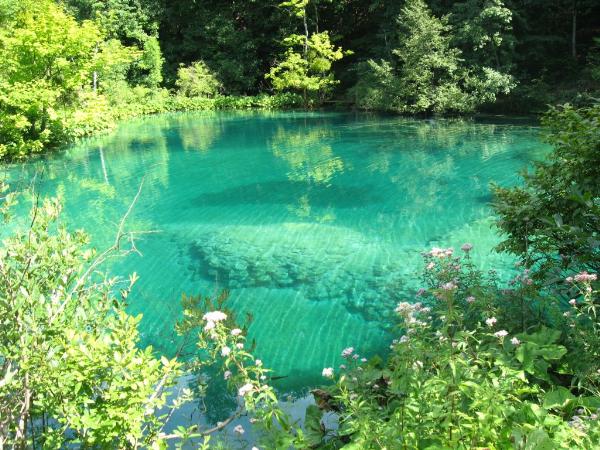
In the Plitvice Lakes National Park, barriers between the lakes
over which are falling magnificent waterfalls and the small falls,
have been created in a special, natural way. Under certain physical
/ chemical and biological conditions, calcium carbonate (CaCO3) is
being extracted from the water, and then is being deposited on the
bottom of the lake, and on the submerged items. It also creates
underwater thresholds and barriers which are elevating above the
water growing constantly in height and width. The barriers are
chalky creations, which are hard, porous and fragile limestone,
full of remains of microscopic mosses and petrified water mosses
that are growing up at the falls. That kind of creation is called
sedra, travertine, tufa, bigar, vapneni macak. Travertine which is
fonned and created by plants, is called plant - formed
travertine.
The famous explorer of traveitine creating process at the Plitvice
Lakes, I.Pevalek, wrote in 1926: "The essence of the Plitvice Lakes
is in travertine and in travertine - forming plants, namely algae
and mosses. Immense number of waterfalls, various barriers between
the lakes and the unique caves have all been created by travertine
- forming plants."
Permanent and continuous creation of plant - formed travertine at
the Plitvice Lakes is the fundamental phenomenon of the National
Park and condition for their existence.

Due to the special qualities of karst base
(limestone, dolomite), the water of the Plitvice Lakes is rich of
dissolved calcium carbonate which is present in form of calcium
bicarbonate Ca(HCO3)2. To explain the chemistry - water of the
Plitvice Lakes is "super - saturated" with this chemical compound.
It comes to that when rainwater, while going through superficial
soil - stratum, absorbs carbon dioxide (CO2), thus creating
carbonic acid (H2CO3) which dissolves limestone and dolomite -
thereby the water becomes significantly mineralized, super -
saturated with calcium and magnesium - bicarbonate. When it breaks
through on the surface, at the tapids and specially at the
travertine barriers, the water splashes and thereby the chemical
balance is being disturbed, calcium carbonate is being secreted in
the form of microcrystals that are being deposited. The super
saturation of water by calcium salts is the basic condition for
travertine creation. Besides, the water has to be clean, must not
contain increased concentration of organic substances which are the
serious obstacle for the unique process of travertine creation at
!he Plitvice Lakes, (proved by SRDOC and associates in 1958). Down
the Korana river from the Korana bridge, travertine creation ends
quite quickly, inspite the supersaturation with calcium
bicarbonate, because of the increasement of concentration of the
organic substance in the water. The presence of water - algae and
some mosses is also a condition for travertine creation at the
Plitvice Lakes, particularly as a factor that forms chalky
secretions. Those water plants are giving form to the created
travertine, and the Plitvice Lakes waterfalls can thank mosses for
their feature, and depending on various species, we could also
differ various biological types of travertine. Let's have a look at
mosses on the travertine barriers over which water is falling down.
Young shoots of mosses are green and soft, they are mostly without
travertine, the ones from the last year are already forming
travertine while the old shoots are of yellow color, completely
covered and petrified, thus being the famous sight of the Plitvice
Lakes - the plant - formed travertine. Recent researches have
proved that millions of algae and bacteria living on the mosses
shoots, are secreting mucus that is adhered to by the first
microcrystals of calcite. Very quick, the other microcrystals are
going to be deposited on that, thus creating the travertine. This
process goes far back in geological past, but only under the
conditions of warm and humid climate, similar to those of today.
2000 years ago, during the last cooling which effected Europe,
travertine was not created at the Plitvice Lakes. Yet today
travertine is being created much faster during the summer, than in
the winter.
To log this cache do the following:
Submit a photo of you and your GPS with a map of the lakes
(spoiler).
Send to an e-mail address eyelet@seznam.cz
answers to these questions:
1 - the date of declaration Plitvice lakes as a National park
2 - name at least 4 of the lakes the national park is made of
3 - what kind of material the underlay of lower lakes is made
of
* 1.1.2011 edit - since the groundspeak changed their terms &
conditions, you are no longer obligated to include photos as a
proof of your visit. Due to this change, you may choose to send a
photo or write to the e-mail what exactly awaits park visitors on
given coordinates besides the info panel.